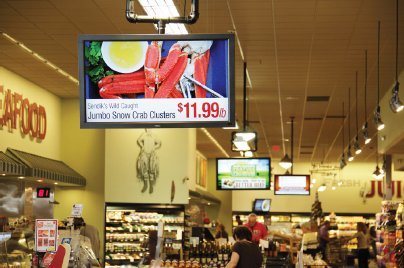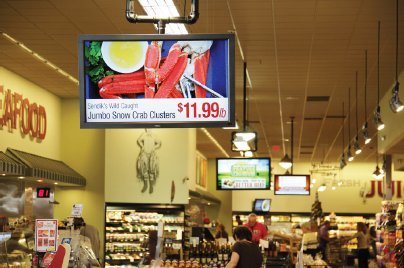
Guest Post: Measuring the Advantages of Retail Digital Signage
November 9, 2011 by guest author, Rich Ventura
 Shipments of digital signage displays to the retail sector are expected to triple by 2013, according to market research firm iSuppli Corp. That’s encouraging news in an industry that faces an uncertain holiday buying season.
Shipments of digital signage displays to the retail sector are expected to triple by 2013, according to market research firm iSuppli Corp. That’s encouraging news in an industry that faces an uncertain holiday buying season.
Yet digital signage alone won’t transform a particular retail store or chain. A thoughtful approach must accompany any digital signage deployment. Digital signage content, location and the ways the retailer engages with customers are important considerations. Having an understanding of how the use of digital signage in retail differs from other vertical markets also can help align various retail interests.
Lastly, knowing how to measure the success of the signage system is paramount in order to understand the ROI of the system.
Key Considerations
It goes without saying that “content is king.” If retailers don’t have the right content running, they won’t attract their target audiences or shape purchasing decisions. Leveraging facts about how an establishment already engages its customers will make digital signage content all the more relevant. Content comes in different flavors.
Active content seeks to engage passersby with direct messages and a call-to-action. The goal is to attract customers to the screen and have them perform an action that will increase overall sales.
Passive content can be categorized as background imagery or background “noise.” Music videos are an example of passive content. The goal is to create an atmosphere that continues to attract the customers to the retail establishment.
Interactive content strikes a balance between active and passive. With this, a retailer is able to have both active and passive content running. Part of the screen can be running videos on hunting equipment, for example, while the active side can be geared toward building the best hunting kit.
The issue of locating digital signage in a retail environment seems like an obvious consideration. But too many organizations fail to plan strategically.
“Where are we going to get the most bang-for-the-buck?”
“How are we going to drive sales?”
Placing digital signage just inside the doors of the store, or near the fitting rooms, is contingent on where a store is going to get the most eyeballs on its products.
Digital signage, in and of itself, may not achieve business objectives. Studies have shown, however, that using digital signage to interact with customers through social media and social networks, or through an interactive kiosk, can draw people in, and align them with a brand on a one-to-one basis – a key element toward increasing sales. This becomes a powerful tool to help build brand equity and a true end-user relationship.
Knowing How Retail Differs
How do retail digital signage content, location and interactivity differ from other industries using digital signage? And what can retailers learn from those differences?
In airports, for example, digital signage is used to convey flight and other information, and some advertising. But with retail, digital signage is 100 percent dedicated toward specific product branding or store-brand building. You won’t find Best Buy information on a Nordstrom digital signage network.
Another difference is that observers will see a lot more video used in retail settings. If not straight video, then some type of motion, and potentially audio, too. Music and other sound elements are unique to retail digital signage. If one enters a retailer who is serious on using digital signage to drive sales, he or she is going to hear some type of audio playing in the background. This can include music, brand-specific sound effects, and even the spoken word.
From my perspective, because of this, digital signage has the greatest opportunity to impact sales in retail.
A traditional big-box store, for example, incorporates video and messaging to pique interest in a product. There’s a huge opportunity to get “Joe Consumer” interested in that product or a series of goods sold in that store. That’s where digital signage in retail delivers. Different brands could be competing against each other in a retail digital signage setting. One doesn’t find that scenario in quick-service restaurants (QSRs), for example.
QSR digital signage takes a different approach. Digital screens are used for menu boards, promotions, entertainment or as triggers for upselling, such as buying another soda. The screens also tend to be more static in nature. In retail, however, digital signage is all about conveying an experience. Progressive retailers put digital screens where they can trigger impulse-buying or increase sales of certain items. Retail digital signage installations also employ video walls to convey the “wow” factor within a store.
On the interactivity front, retailers tend to use large-screen digital signage or smaller digital signage kiosks to convey that one-to-one relationship with consumers. Offering special deals through Facebook or Twitter – or using a smart phone to scan a digital sign for coupons or other promotions – is growing in popularity. Interactivity is the retail industry’s bread-and-butter technique for building relationships and for growth.
Measuring Success
There are several ways to measure success. First, does a retailer’s point-of-sale (POS) system show an increase in sales as a result of digital signage content? Has its advertising budget been positively impacted?
Sendik’s Food Markets discovered what digital signage could do for its Milwaukee-area stores. Printing costs had gone up, and the printing process was getting more arduous to manage. Sometimes, sales were nearly over by the time printed signs appeared in Sendik’s stores. Digital signage eliminated printing, shipping and in-store labor costs, and pricing information on store items could be changed in minutes – if market pressures dictated.
While connecting existing store technologies to one’s digital signage is an effective way to measure impact, new methods also are coming to the forefront.
Intel and other software companies are developing audience measurement systems that collect the aggregate data of people in front of digital screens, which can help determine the right content to run, where to locate the digital signs and what level of interactivity will favorably affect the bottom line. Intel’s Audience Impression Metrics (AIM) suite can track what people are looking at on screens and their buying habits. Such capabilities give retailers the knowledge they need to drive sales.
If a retailer knows, for example, that teenage girls are its biggest store audience between the hours of 3-5 pm on certain days, then it can tailor its digital signage content to maximize purchasing opportunities. The one-to-one relationship is realized.
And that one-to-one relationship is a key factor that digital signage and related technologies are driving in the retail environment.
Richard Ventura is Director of Sales – Vertical Solutions for NEC Display Solutions (www.necdisplay.com). He can be reached at rventura@necdisplay.com.




Leave a comment